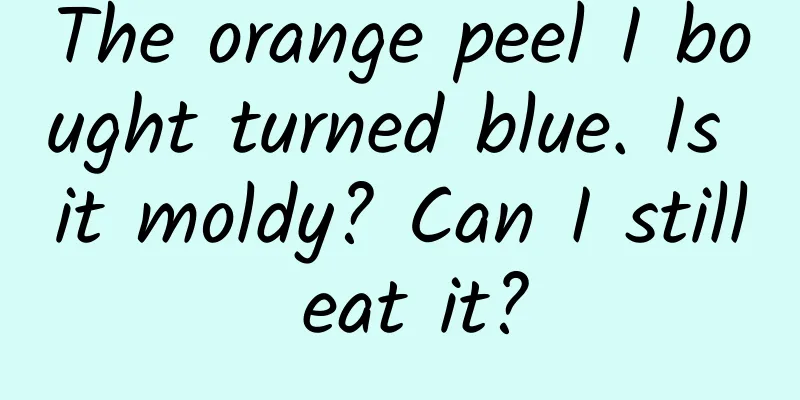The orange peel I bought turned blue. Is it moldy? Can I still eat it?

|
Wogan is a citrus fruit that everyone likes. Its flesh is plump, tender and juicy, and it tastes sweet, making it particularly popular. However, some friends found that when they bought Wogan, after peeling the peel, the inside of the peel turned light blue , which surprised everyone! There are many people who have encountered similar situations: The picture comes from a social platform Why does the peel of the Wogan orange turn blue? Can you still eat it? You will understand after reading this article! The possible reason why the peel turns blue: Copper ion oxidation A common reason for the inner side of the Wogan peel to turn blue is that there is too much copper in the soil. Copper easily oxidizes when it encounters air, just like iron rusts and turns red, but copper rusts and turns blue. This phenomenon has a name among fruit farmers, called **"blue change"**, which is actually a very normal situation. If the blue color inside the peel is limited to the sponge layer, and the flesh is normal in color and has no odor, it can usually be judged as copper ion oxidation. In this case, after peeling off the blue sponge layer, the flesh is edible. So how does copper ion oxidation occur? During the planting process, fruit farmers use some copper-containing pesticides, such as Bordeaux mixture, to prevent and control pests and diseases. Although this pesticide can protect the branches and leaves, the excess copper ions may penetrate into the inner side of the peel. When the peel is peeled, the copper ions come into contact with the air and will undergo an oxidation reaction, turning blue. Although this blue color looks a bit scary, it does not pollute the flesh. However, we would like to remind everyone that although copper ion oxidation itself is not a problem, if the blue color on the inside of the peel is very thick, or there are other abnormal conditions, it is best to be cautious. The second possible reason why the peel turns blue: Environmental factors or planting management issues The blue discoloration of the inner side of the Wogan peel may also be related to the planting environment or management measures . For example, the soil and climate conditions in some areas are not suitable for growing Wogan, or improper fertilization and poor water management during the planting process may cause the Wogan to "turn blue". The requirements of the growing environment of Wogan are actually quite high. If the soil pH is not suitable, or if the soil lacks certain nutrients, Wogan will easily "get sick" due to malnutrition. For example, in some overly acidic soils, the roots of Wogan may not be able to absorb nutrients normally, resulting in poor fruit development and the "blue change" phenomenon. In addition to environmental factors, planting management is also very important. If fertilization is improper, such as applying too much nitrogen fertilizer, the branches and leaves of the Wogan will grow lush, but the quality of the fruit may be affected. In addition, if water management is not good, such as watering too much or too little, the Wogan will be "uncomfortable" due to poor drainage, and various physiological problems will occur. Copyright images in the gallery. Reprinting and using them may lead to copyright disputes. The three possible reasons why the peel turns blue: Precipitation of natural pigments such as anthocyanins Anthocyanin is a natural pigment found in many fruits and vegetables. It can make fruits appear in different colors, such as red, purple or blue. If the fruit is subjected to some environmental stress, such as temperature changes or humidity changes, which stimulates the synthesis of anthocyanin, it may cause the skin to "turn blue". If the blue color on the inside of the Wogan peel is lighter and looks more uniform, and can be easily removed by gently wiping the blue part with a wet paper towel, it is likely that anthocyanin or copper ion oxidation. In this case, the flesh is generally safe. However, although anthocyanin is a natural pigment, if the Wogan orange is accompanied by other abnormal conditions, such as the flesh is soft or has an odor, it is still not edible. The possible reason why the peel turns blue: Bacterial or fungal infection In addition to copper ion oxidation, the blue color of the inner skin of the mandarin orange may also be caused by bacterial or (among fungi) mold infection. In a hot and humid environment, fungal spores can easily invade the inside of the mandarin orange, causing it to deteriorate and mold. If the blue color inside the mandarin orange is caused by mold infection, it is usually accompanied by other signs of deterioration, such as odor, soft flesh, or mold spots on the surface. During the growth process of Wogan, the peel may have some small wounds, such as being bitten by insects or accidentally broken during the picking process. These small wounds are like "doors wide open", giving bacteria and mold the opportunity to get in. Once bacteria or mold enter the fruit, they will multiply rapidly, causing the Wogan to deteriorate. Problems can easily arise during storage and transportation of Wogan. If the storage environment is humid or the temperature is too high during transportation, Wogan will easily deteriorate. For example, in order to save costs, some merchants pile Wogan in a humid warehouse. Over time, Wogan will easily become moldy and turn blue. If the inside of the peel of the mandarin orange you bought turns blue, and there are other abnormalities, such as soft flesh, odor, or mold on the peel, it is likely that it is infected with bacteria or mold. In this case, the mandarin orange should never be eaten, because the mold may produce toxins that are harmful to human health. In general, the blue color of the inner side of the Wogan peel may be caused by several reasons. For example, it may be caused by copper ion oxidation, which is a normal natural phenomenon, just like iron rusting; it may also be caused by bacteria or mold. If there are mold spots on the peel, the flesh is soft, or there is a wine smell or odor, then you have to be careful, because this means that the Wogan may have deteriorated; in addition, if the planting environment is not good or the storage is not done properly during transportation, anthocyanins will be deposited on the white skin, which may also cause the Wogan to turn blue. Recommendations for purchasing and storing Wogan Finally, here are some suggestions on how to choose and store Wogan: When buying Wogan, try to choose those with uniform peel color and smooth surface. If there are obvious wounds on the peel or the color is abnormal, it is best not to buy it. You can also press the Wogan lightly with your hand. If the flesh is elastic, it means it is fresh ; if it is soft when pressed, it may not be fresh. Copyright images in the gallery. Reprinting and using them may lead to copyright disputes. After you buy the Wogan, it is best to place it in a ventilated and dry place . If it is placed in a humid environment, it is easy to mold. If you want to put the Wogan in the refrigerator, remember to put it in a fresh-keeping bag to prevent moisture from condensing on the peel. If you find that the inside of the Wogan peel has turned blue, don't panic. Follow the method mentioned above to determine what caused it. If it is just copper ion oxidation and the flesh looks normal, you can eat it with confidence; but if the flesh is soft, has an odor, or there are mold spots on the peel, the blue is too dark, etc., for your own health, it is better not to eat it, safety first! Planning and production Author: Zhang Cong, a graduate student in agronomy and seed industry, majoring in vegetables Review丨Yang Laisheng, Researcher at Lanzhou Academy of Agricultural Sciences Planning丨Yang Yaping Editor: Yang Yaping Proofread by Xu Lailinlin |
<<: Cockatoos know how to season and love to cook dark dishes | Natural Trumpet
Recommend
Scientists, we want to tell you: 50th anniversary exhibition of China's overcoming the difficulties of hybrid rice
In 2023, it will be the 50th anniversary of China...
How to operate a Douyin corporate account without experience and manpower?
With the rise of short video platforms, more and ...
When people get old, do they really smell like old people?
People with life experience know that many elderl...
Beware! Extraterrestrial "Assassins"
Beware! Extraterrestrial "Assassins" In...
5 minutes to show you how to play with App automation testing
Preface App automated testing has always been a f...
After watching ofo’s new ad, I threw away the client’s brief!
Recently, ofo, the shared yellow bike company, re...
When Gree and Midea become the Apple of the air-conditioning industry, what is the purpose of the nine-year patent dispute between Samsung and others?
The domestic air-conditioning market has now ente...
What time should I check the examination venue for the college entrance examination? What should I pay attention to when checking the examination venue for the college entrance examination? 2020 Shandong College Entrance Examination Examination Time
Tomorrow morning, the 2020 college entrance exami...
How can Douyin increase followers quickly and effectively?
There are three ways to increase followers: conte...
WeChat nicknames can now be circled, try it now
Dan Di, who is dedicated to making WeChat fancy, ...
Li Pi's "The Fifth Session of Douyin Short Video Sales Training Camp" Listen and do as you are told to ensure orders
Introduction to the training course content: No re...
How was the world's first telegram sent? Uncovering the birth and evolution of the telegram
Throughout human history, the transmission of inf...
Why is the most peculiar appearance of the Yangtze River at its source?
Branches and roads Beaches The longest river in A...
Using "cocoa butter substitute" to impersonate chocolate? Be careful when buying chocolate!
A well-known brand of chocolate food has always b...
How much does it cost to attract investment in the Bengbu Tea Mini Program? What is the investment price of Bengbu Tea Mini Program?
The overall investment promotion of Bengbu Tea Mi...









